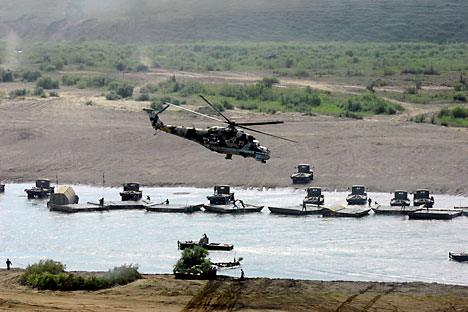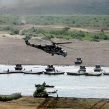
Russia’s Military Doctrine Reflects Putin’s Paranoia and Siege Mentality
Publication: Eurasia Daily Monitor Volume: 12 Issue: 2
By:

Moscow published its new Military Doctrine on December 26, 2014 (Kremlin.ru, December 26, 2014). And without going into the details (see accompanying article), clearly this document reflects the mentality of a state under siege on all fronts. Moreover, almost all of the multiple threats listed in the doctrine had long since been outlined and stated in the Russian press by one or another official. Indeed, on December 10, Chief of the General Staff, General Valery Gerasimov, said, “Attempts to pressure our country are being made [by the West and the North Atlantic Treaty Organization] in all vitally important spheres.” These activities, he asserted, comprise efforts to reduce Russia’s military-economic potential, slow down its scientific-technological development in strategically important areas, and increase NATO’s military presence near Russia’s borders, among others (Interfax, December 10, 2014).
These, along with other identified threats found their way back into the 2014 version of the Russian Military Doctrine. Even though some are listed as “dangers” rather than “threats” (probably for political reasons), there does not seem to be any fundamental policy distinction (in fact rather than in rhetoric) between these terms. The following are listed as threats or dangers to Moscow: missile defense, or efforts to nullify the offensive potential of Russian nuclear forces; NATO’s “buildup” near Russia’s borders; the US concept of prompt global strike; activities that undermine patriotism; growth in global terrorism and radicalism; informational influence on the Russian population “with a view to undermine the historical and patriotic traditions”; threats to Russia’s Arctic energy and defense interests and installations; foreign funding of domestic political forces and public movements; private military companies on Russian borders; armed action in neighboring countries; and the weaponization of outer space (Kremlin.ru, December 26, 2014).
Considering this wide list of both internal and external threats, as well as Moscow’s repeated assertions that threats to the Russian state abound and are growing, the latest iteration of the country’s Military Doctrine in many ways echoes a Stalinist mentality. Besides overt and indirect allusions to capitalist or imperialist encirclements, the document also paints links between domestic and foreign enemies. Moreover, Russia’s Military Doctrine describes an ideological and strategic state of siege between the West and Russia. Not surprisingly, therefore—and quite unlike the US national security concept or defense doctrine—the Russian 2014 document devotes enormous attention to issues of mobilization of the country and economy for war (Kremlin.ru, December 26, 2014). And, in the hoary tradition of Russian proclamations, such tools and weapons are precisely those Russia has used, uses, and will use against its enemies in the West, if not elsewhere.
Beyond the 2014 Military Doctrine’s all-encompassing threat assessment, there are other interesting and occasionally dangerous signs for the West within this document. On the one hand, the doctrine seems to continue Russia’s trend of restricting its nuclear operations and eschews any talk of a justification for a preemptive nuclear strike. Yet, on the other hand, it does reflect Russia’s growing confidence in its newly acquired high-tech conventional arsenal by introducing the concept of “non-nuclear deterrence.” This concept, associated with several Russian thinkers like Andrei Kokoshin, means that Russia believes it no longer needs to resort as quickly to a first nuclear strike if it is thrown on the defensive (Kremlin.ru, December 26, 2014). Almost counter-intuitively, this could entail more danger for Europe if Russia’s confidence in its conventional military arm grows.
The 2014 Military Doctrine fully lives up to the Russian habit of blaming the mirror for a bad reflection. Although the document was finalized over the course of 2014, nowhere does the new doctrine talk about Russia’s invasion of Ukraine. Nor does the document ever mention Moscow’s military superiority in the Baltic theater. Beyond that, the 2014 doctrine also provides further reason to expect a Russian incorporation of Georgia’s provinces of Abkhazia and South Ossetia as the document expressly discusses defense cooperation with both of them.
China also deserves to be discussed in relation to the new Russian Military Doctrine. The document proposes to “coordinate [Russian] efforts [with China] to deal with military risks in the common space of the Shanghai Cooperation Organization [SCO].” It also provides for the creation of joint missile defense systems. While Moscow has pursued this with the West in the past, pledges of a joint system with Beijing could serve as a warning to NATO or the US.
Analysts like Dmitri Trenin deny that Moscow is seeking an alliance with China (Cer.org.uk, February 13, 2012). However, Russian Defense Minister Sergei Shoigu explicitly said in Beijing that Russia and China confront not only US threats in the Asia-Pacific but also US-orchestrated “color revolutions” and Islamic terrorism. Therefore, the “issue of stepping up this cooperation [between Russia and China] has never been as relevant as it is today,” he noted (Interfax, November 18, 2014). Specifically, Russia’s defense minister meant enhanced Sino-Russian security cooperation (through unspecified means), both bilaterally and within the SCO. Both Shoigu and his deputy minister, Anatoly Antonov, decried US policies in Central Asia as well as East Asia, alleging that Washington was attempting to spark color revolutions and boosting support for Islamic terrorism in Southeast and Central Asia. Shoigu further stated that “[i]n the context of an unstable international situation, the strengthening of good-neighborly relations between our countries acquires particular significance. This is not only a significant factor in the states’ security, but also a contribution to ensuring peace throughout the Eurasian continent and beyond” (Ministry of Defense of the Russian Federation, November 18, 2014; Nezavisimaya Gazeta, November 20, 2014). According to Shoigu, “During talks with [Chinese defense minister] Comrade Chang Wanquan, we discussed the state and prospects of Russian-Chinese relations in the military field, exchanged opinions on the military-political situation in general and the APR [Asia-Pacific Region] in particular.” He added, “We also expressed concern over US attempts to strengthen its military and political clout in the APR. […] We believe that the main goal of pooling our effort is to shape a collective regional security system” (ITAR-TASS, November 18, 2014).
Defense Minister Shoigu’s words thus clearly point to Moscow’s efforts to initiate a working alliance with Beijing. On these grounds alone, the 2014 Russian Military Doctrine, which dictates just such a relationship with China, deserves more careful scrutiny by policymakers in the West.




